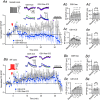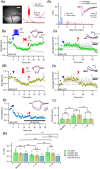Input-specific bidirectional regulation of hippocampal CA3 pyramidal cell excitability
- PMID: 40538127
- PMCID: PMC12320203
- DOI: 10.1113/JP288350
Input-specific bidirectional regulation of hippocampal CA3 pyramidal cell excitability
Abstract
High-frequency mossy fibre (MF) inputs trigger a sustained increase in excitability to perforant pathway (PP) inputs in CA3 pyramidal cells (CA3-PC) by reducing Kv1.2 levels at distal apical dendrites, known as long-term potentiation of intrinsic excitability (LTP-IE). LTP-IE enhances excitatory postsynaptic potential (EPSP)-to-spike coupling at PP synapses, facilitating Hebbian LTP of synaptic weights. Prolonged hyperexcitability is detrimental, yet it is little understood how LTP-IE is restored in CA3-PCs. Here we show that MF-induced LTP-IE can be reversed through the burst firing of a CA3-PC elicited by PP or recurrent synaptic inputs. This reversal was impeded by the oxidative bias of cellular redox state or intracellular Zn2+ signalling. Because high-frequency PP inputs to MF-primed CA3 pyramidal cells not only induce homosynaptic LTP but also restore hyperexcitability, this input-specific bidirectional regulation of intrinsic excitability may provide a cellular basis for understanding ensemble dynamics in the CA3 network. KEY POINTS: Intrinsic excitability plays a pivotal role in recruiting principal cells to neuronal memory ensembles. Mossy fibre inputs prime hippocampal CA3 pyramidal cells by enhancing their intrinsic excitability and excitatory postsynaptic potential (EPSP)-to-spike coupling at perforant path (PP) synapses. High-frequency PP inputs to such primed cells not only induce long-term potentiation of synaptic weights but also restore the high excitability state to baseline. This input-specific bidirectional regulation of intrinsic excitability may offer a cellular basis for understanding the ensemble dynamics in the hippocampal CA3 network.
Keywords: CA3; Kv1.2; hippocampus; intrinsic plasticity; mossy fibre; pyramidal cell; redox; tyrosine phosphatase.
© 2025 The Author(s). The Journal of Physiology published by John Wiley & Sons Ltd on behalf of The Physiological Society.
Conflict of interest statement
None declared.
Figures








References
-
- Chiarugi, P. , & Giannoni, E. (2005). Anchorage‐dependent cell growth: Tyrosine kinases and phosphatases meet redox regulation. Antioxidants & Redox Signaling, 7, 578–592. - PubMed
-
- Davis, M. J. , Wu, X. , Nurkiewicz, T. R. , Kawasaki, J. , Gui, P. , Hill, M. A. , & Wilson, E. (2001). Regulation of ion channels by protein tyrosine phosphorylation. American Journal of Physiology‐Heart and Circulatory Physiology, 281(5), H1835–H1862. - PubMed
MeSH terms
Substances
Grants and funding
LinkOut - more resources
Full Text Sources
Miscellaneous
